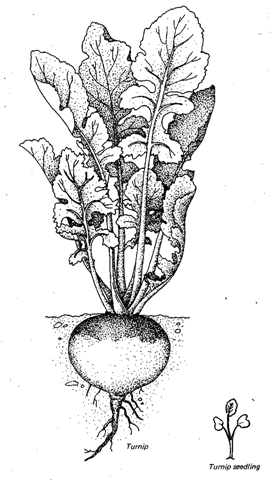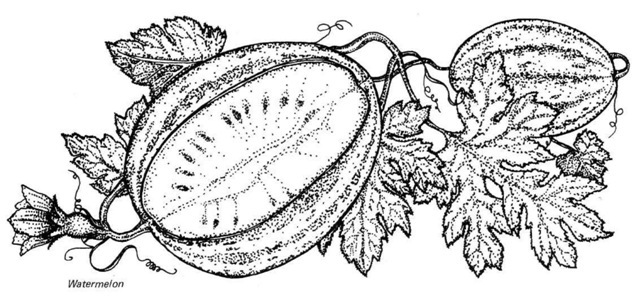Common name: turnip Botanical name: Brassica rapa Origin: northeastern Europe, Siberia
Varieties
Shogin (30 days); Foliage Turnip (30 days); Tokyo Cross (35 days); Tokyo Market (35 days); Just Right (40 days); Purple Top White Globe (57 days).
Description
The turnip, a hardy biennial grown as an annual, sports a rosette of hairy, bright green leaves growing from a root—Awhich is not really a root, but a swelling at the base of the stem. The turnip is more commonly grown for use as a root vegetable, but can also be grown for the leaves, which are used as greens. Turnips originated in the Mediterranean in prehistoric times. The rutabaga, a younger cousin, is believed to have come about in the Middle Ages from a cross between a turnip and a cabbage. Englishmen have been known to refer to each other as “turniphead”; this is not a compliment, as turnips are often considered to be rather dull. In fact, they’re quite versatile.
Where and when to grow
Turnips are a cool-weather crop, grown in the fall, winter, and spring in the South and in the spring and fall in the North. They don’t transplant well, so grow them from seed, and plant them two to three weeks before the average date of last frost for your area.
How to plant
Turnips tolerate partial shade and need soil that’s high in organic matter and well-drained but able to hold moisture. Too much nitrogen in the soil encourages A the plant to produce leaves and a seed stalk rather than a good-sized root, so when you’re preparing the soil for planting, work in a low-nitrogen (5-10-10) fertilizer at the rate of one pound per 100 square feet or 10 pounds per 1,000 square feet. Plant seeds half an inch deep in

How to plant
Watermelons must have full sun, and prefer well-drained soil that holds moisture well. When you’re preparing the soil for planting, work in a complete, well-balanced fertilizer at the rate of one pound per 100 square feet or 10 pounds per 1,000 square feet. Crow watermelons in inverted hills, made by removing an inch of soil from a circle 12 inches across and using the soil to form a rim around the circle. Space the hills six feet apart, and plant four to five seeds in each hill. When the seedlings have developed three or four true leaves, thin them to leave the strongest one or two seedlings in each hill. Cut the thinned seedlings with scissors at soil level to avoid damaging the survivors’ root systems. Where cucumber beetles, other insects or weather are a problem, wait a bit before making the final selection. If you’re using transplants, put two or three In each hill.
Fertilizing and watering
Fertilize before planting and again at midseason, at the same rate as the rest of the garden. Detailed information on fertilizing is given in “Spadework: The Essential Soil” in Parti.Watermelons are 95 percent water, so make sure they have enough to keep them growing well. Do not let the soil dry out, and use a mulch to keep the soil moisture even.
Special handling
As the watermelons develop, provide a support for the fruit. If they’re growing on a fence or
trellis, support the fruit with a net. If the vines are trailing on the ground, put a board under the fruit to keep it off the ground. Mulch helps keep the fruit clean as well as regulating soil moisture.
Pests
Cucumber beetles may visit your watermelon vines. They don’t cause much feeding damage, but they carry cucumber bacterial wilt; hand-pick them off the vines as soon as they appear. Watermelons are a good crop for the organic gardener who has lots of space. Detailed information on pest control are given in “Keeping Your Garden Healthy” in Parti.
Diseases
Watermelons are susceptible to anthracnose and wilt. Planting

disease-resistant varieties when they’re available and maintaining the general cleanliness and health of your garden will help cut down the incidence of disease. Don’t handle the vines when they’re wet. If a plant does become infected, remove it before it can spread disease to healthy plants. Detailed information on disease prevention is given in “Keeping Your Garden Healthy” in Part 1.
When and how to harvest
If one watermelon gets an early start on a vine it can suppress all further activity until it matures. Some people suggest pinching out this first watermelon to encourage more melons, but this is a gamble because, sometimes no more watermelons will set. It’s easier to judge when a watermelon is ripe than it is with some other types of melon; a

Watermelon seedling
watermelon is ready to harvest when the vine’s tendrils begin to turn brown and die off. A ripe watermelon will also sound dull and hollow when you rap it with your knuckles.
Storing and preserving
A watermelon will store for up to one week in the refrigerator — it takes about 12 hours to chill a large one thoroughly before you eat it. If you have a lot of melons, store them in a cool, moderately moist place for two to three weeks. You can freeze the flesh of the watermelon and make pickles with the rind.
Serving suggestions
Slices of fresh watermelon make a wonderful summer cooler. Scoop out the flesh with a melon bailer and add to other types of melon for a cool fruit salad — pile the fruit into a muskmelon half. For a great party dish, serve a big fruit salad in the scooped out half-shell of the watermelon—or carve the shell into a basket. Make pickles with the rind.
Yarn,
See Sweet potato
Zucchini,
See Squash, summer
